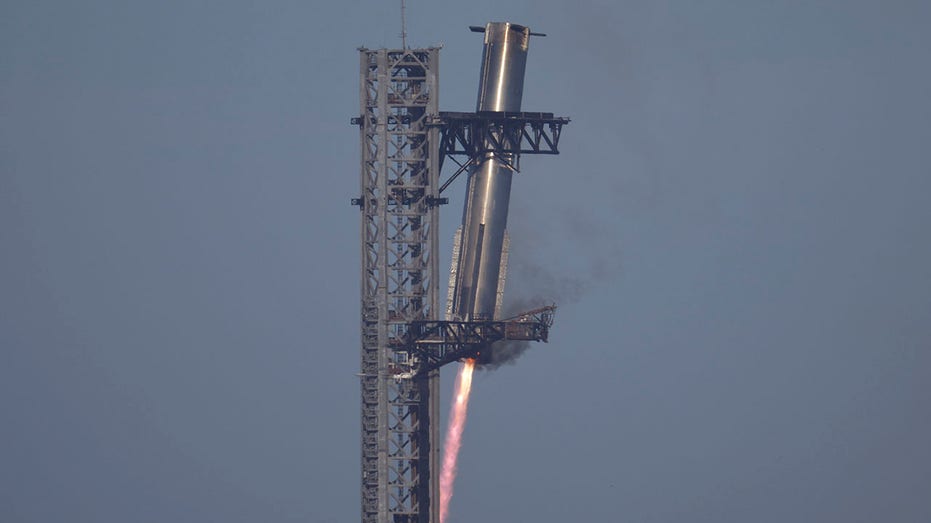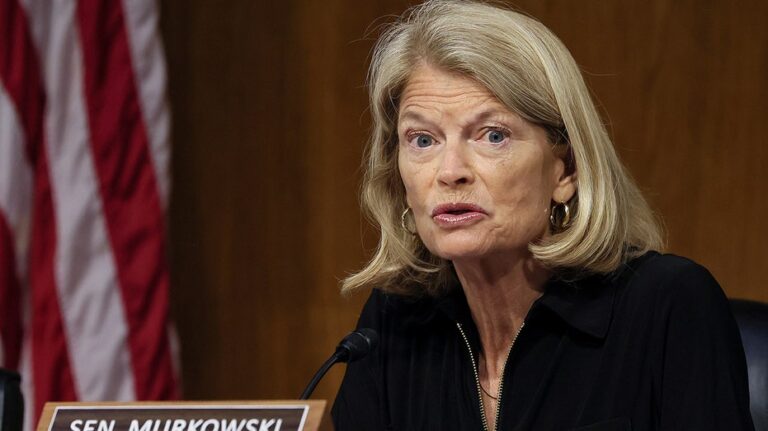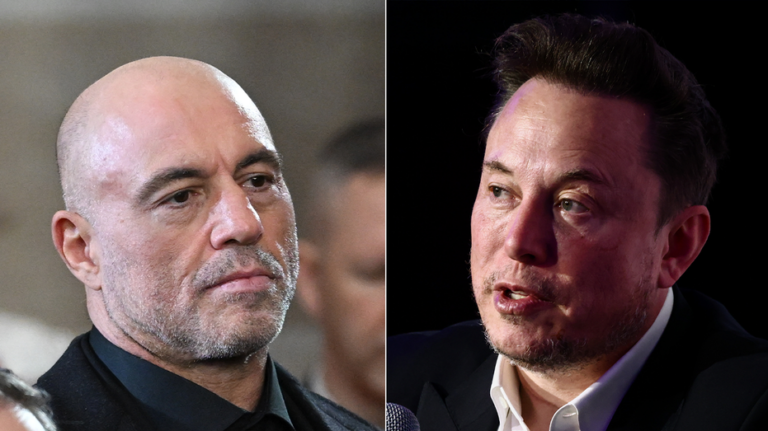
Rocket debris from a SpaceX’s Starship Super Heavy booster was spotted in the sky after a “rapid unscheduled disassembly” before part of the device successfully returned to its “chopsticks” for a second time.
The vehicle lifted off from SpaceX’s Starbase test site at Boca Chica, Texas. The booster then separated about two minutes and 45 seconds after liftoff and headed back towards Starbase, Space News reported.
The spacecraft’s six engines appeared to shut down one by one, with contact lost just 8 1/2 minutes into the flight, SpaceX said.
POWERFUL WEBB TELESCOPE CAPTURES MOST DISTANT KNOWN GALAXY, SCIENTISTS SAY
“Starship experienced a rapid unscheduled disassembly during its ascent burn,” SpaceX said in a statement. “Teams will continue to review data from today’s flight test to better understand root cause. With a test like this, success comes from what we learn, and today’s flight will help us improve Starship’s reliability.”
It was the seventh test flight for the powerful rocket.
The spacecraft was supposed to soar across the Gulf of Mexico from Texas on a near loop around the world similar to previous test flights. It was packed with 10 dummy satellites for practice at releasing them. It was the first flight of this new and upgraded spacecraft.
POWERFUL WEBB TELESCOPE SPIES SPECTACULAR STAR BIRTH CLUSTER BEYOND THE MILKY WAY
“It was great to see a booster come down, but we are obviously bummed out about ship,” said SpaceX spokesman Dan Huot.
The Federal Aviation Administration (FAA) told Fox News Digital that it was assessing the operation.
“The FAA is aware an anomaly occurred during the SpaceX Starship Flight 7 mission that launched from Boca Chica, Texas, on Jan. 16,” the agency said. “The FAA briefly slowed and diverted aircraft around the area where space vehicle debris was falling. Normal operations have resumed.”
The last data received from the spacecraft indicated an altitude of 90 miles and a velocity of 13,245 mph.
The 400-foot rocket had thundered away in late afternoon from Boca Chica, near the Mexican border. Elon Musk said he plans to launch actual Starlinks on Starships before moving on to other satellites and, eventually, crews.
NASA Administrator Bill Nelson congratulated SpaceX, while noting that “spaceflight is not easy.”
“It’s anything but routine,” he wrote on X. “That’s why these tests are so important—each one bringing us closer on our path to the Moon and onward to Mars through.”
MERGER OF MASSIVE BLACK HOLES FROM EARLY UNIVERSE UNCOVERED BY WEBB TELESCOPE, SCIENTISTS SAY
Video footage of debris falling from the sky seemed to perplex people on the ground.
“Success is uncertain, but entertainment is guaranteed!” Musk wrote on X in response to one video posted online.
In a subsequent post, he said that “improved versions of the ship & booster already waiting for launch.”
The Associated Press contributed to this report.
Rocket debris from a SpaceX’s Starship Super Heavy booster was spotted in the sky after a “rapid unscheduled disassembly” before part of the device successfully returned to its “chopsticks” for a second time.
The vehicle lifted off from SpaceX’s Starbase test site at Boca Chica, Texas. The booster then separated about two minutes and 45 seconds after liftoff and headed back towards Starbase, Space News reported.
The spacecraft’s six engines appeared to shut down one by one, with contact lost just 8 1/2 minutes into the flight, SpaceX said.
POWERFUL WEBB TELESCOPE CAPTURES MOST DISTANT KNOWN GALAXY, SCIENTISTS SAY
“Starship experienced a rapid unscheduled disassembly during its ascent burn,” SpaceX said in a statement. “Teams will continue to review data from today’s flight test to better understand root cause. With a test like this, success comes from what we learn, and today’s flight will help us improve Starship’s reliability.”
It was the seventh test flight for the powerful rocket.
The spacecraft was supposed to soar across the Gulf of Mexico from Texas on a near loop around the world similar to previous test flights. It was packed with 10 dummy satellites for practice at releasing them. It was the first flight of this new and upgraded spacecraft.
POWERFUL WEBB TELESCOPE SPIES SPECTACULAR STAR BIRTH CLUSTER BEYOND THE MILKY WAY
“It was great to see a booster come down, but we are obviously bummed out about ship,” said SpaceX spokesman Dan Huot.
The Federal Aviation Administration (FAA) told Fox News Digital that it was assessing the operation.
“The FAA is aware an anomaly occurred during the SpaceX Starship Flight 7 mission that launched from Boca Chica, Texas, on Jan. 16,” the agency said. “The FAA briefly slowed and diverted aircraft around the area where space vehicle debris was falling. Normal operations have resumed.”
The last data received from the spacecraft indicated an altitude of 90 miles and a velocity of 13,245 mph.
The 400-foot rocket had thundered away in late afternoon from Boca Chica, near the Mexican border. Elon Musk said he plans to launch actual Starlinks on Starships before moving on to other satellites and, eventually, crews.
NASA Administrator Bill Nelson congratulated SpaceX, while noting that “spaceflight is not easy.”
“It’s anything but routine,” he wrote on X. “That’s why these tests are so important—each one bringing us closer on our path to the Moon and onward to Mars through.”
MERGER OF MASSIVE BLACK HOLES FROM EARLY UNIVERSE UNCOVERED BY WEBB TELESCOPE, SCIENTISTS SAY
Video footage of debris falling from the sky seemed to perplex people on the ground.
“Success is uncertain, but entertainment is guaranteed!” Musk wrote on X in response to one video posted online.
In a subsequent post, he said that “improved versions of the ship & booster already waiting for launch.”
The Associated Press contributed to this report.



